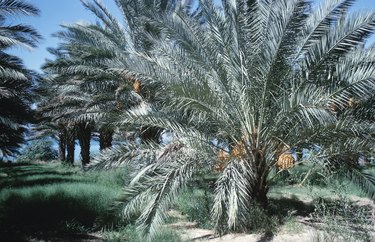
Pygmy date palms (Phoenix roebelenii) are often grown in containers for patios or poolsides and reach heights of six to 12 feet. It has a curving trunk topped with dense, arching foliage consisting of leaves that are approximately three feet in length. Although it is fairly easy to care for and more resistant to disease than many other varieties of palm, pygmy date palms can die prematurely for a number of reasons.
Pestalotiopsis
Video of the Day
Pestalotiopsis is a fungus that may cause bud rot in pygmy date palms and can kill the tree. Early symptoms include leaf spots that are small, yellow, brown or black spots that gradually enlarge in size and turn gray with a black outline. Identification of the fungal pathogen is required to diagnose the disease. Local county extension offices in some areas may perform a laboratory diagnosis. According to the University of Florida, pestalotiopsis is best managed through a combination of water management, sanitation, injury prevention and nutrition. Fungicides may be used to prevent spread of the disease.
Video of the Day
Scale
Red date scale (Phoenicococcus marlatti) may be fatal to pygmy date palms. The mature scale, which is less than 1/16 inch long, spherical, and red or reddish brown, may be found nested in a mass of white cottony wax at base of newly emerging fronds, exposed roots and the trunk. The infestation results in premature leaf aging and drying of the fruit, and the plant's normal metabolic functions may be disrupted with heavy infestations, sometimes resulting in death. Insecticides are required to control a scale infestation. Options include contact sprays, horticultural oil and insecticidal soaps, and systemic insecticides. The latter prove to be the most effective, killing the insects as they feed.
Freezing Temperatures
Pygmy date palm trees, recommended for USDA hardiness zones 10a through 11, are cold hardy to just below freezing temperatures. They may tolerate lower temperatures if the cold snaps are brief and day temperatures climb to above freezing, but extended periods of freezing temperatures may kill them. The University fo Florida points out that palm trees, unlike other types of trees, such as hardwoods, have only one point of growth, which is at the top. Once this area dies or freezes, the palm may die. Cold protection, such as wrapping cloth or plastic around the palm's trunk and mulching the area around the tree heavily with mulch, straw, hay, pine needles or leaves, may help prevent damage if temperatures do not drop below freezing for an extended period of time.
Potassium Deficiency
Potassium deficiency is another condition which may kill a pygmy date palm. Symptoms of potassium deficiency appear first on the oldest leaves, with the tips turning orange. The rest of the leaf usually remains green. The leaves become dry and stunted as the condition progresses and then begin to fall off. Eventually, the palm's canopy may contain only a few leaves, and death often follows. Applications of fertilizers containing potassium will treat palms already deficient. Treatment may be necessary for one to two years to be effective.
- University of Florida IFAS Extension: Scale Insect Killing Pygmy Date Palms
- University of Florida IFAS Extension: Pestalotiopsis (Pesalotia) Diseases of Palm
- University of Florida IFAS Extension: Phoenix Roeblelenii-Pygmy Date Palm
- University of Florida IFAS Extension: Potassium Deficiency in Palms
- University of California IPM: Palm Diseases in the Landscape
- Texas Riviera: Pygmy Date Palm Winter Protection